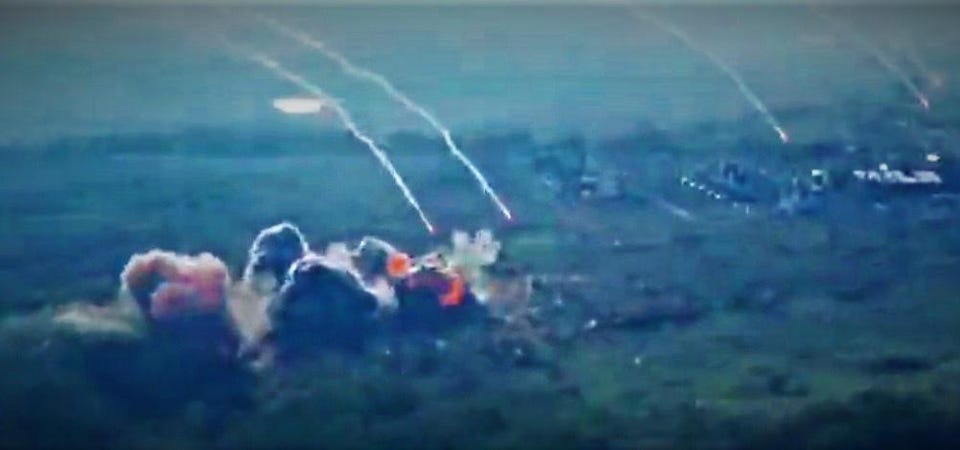After going missing for a couple of critical weeks in Ukraine, the Russian air force is back. Videos that appeared online this week seem to confirm an air strike on Ukrainian positions by Russian air force fighter-bombers. That’s good news for the Russians as they continue retreating from a determined Ukrainian counteroffensive that kicked off in southern and eastern Ukraine starting in late August.
There’s bad news for the Russians, too. The same videos depicting the Russian strikes on Ukrainian forces in Spirne, in eastern Ukraine’s Donbas region southwest of the Russian-occupied city of Lysychansk, also confirm that the Ukrainians hold Spirne, which until last week was under Russian control. In other words, Russian warplanes have returned to the battlefield.
But only to bomb positions Russian ground forces recently abandoned. The bombing of Spirne in broad daylight on or before Thursday involved at least two strike aircraft—one of them apparently a twin-engine, two-seat Su-34—as well as a drone that recorded the attack, probably for post-strike damage assessment. In the video, the Su-34 and a trailing aircraft, flying hundreds of feet above the ground, drop what appear to be parachute-retarded, unguided bombs.
There’s no evidence of Ukrainian air-defense activity, but the warplanes pop flares as they egress, just to be safe. The target of the raid seems to be Ukrainian positions around a gas facility near Spirne. It’s unclear whether the aircraft struck anything of military value—there aren’t any obvious secondary explosions.
But other Russian strikes on the same positions have been at least somewhat successful. At least one Ukrainian soldier was wounded or killed in an artillery barrage in the same area around the same time. A Russian drone captured the aftermath of that attack, as Ukrainian troops dragged away the dead or wounded and packed them into an armored vehicle for evacuation.
The Thursday or earlier air raid is striking because, for more than two weeks after Ukrainian brigades counterattacked—first in the south just north of occupied Kherson, then in the east outside the free city of Kharkiv—the Russian air force seemed to go missing in action. There was visual evidence of Ukrainian jets flying close-air-support missions, but no evidence of Russian jets doing the same. This despite the Russians having 300 or more warplanes in and around Ukraine, and the Ukrainians having just a hundred or so.
Analysts chalked up the disparity to the enduring strength of Ukrainian air-defenses, recently bolstered by dozens of ex-German Gepard mobile guns, as well as the waning strength of Russian air-defenses and Ukrainian MiG-29 and Su-27 fighters continue harrying them with American-made anti-radar missiles. Doctrine also has been an issue. Ukrainian pilots have swapped tactics with NATO pilots.
This should encourage them to think and act independently. Intelligence the Americans and other allies supply also could help Ukrainian aviators to react to changing conditions on the ground. Russian doctrine, on the other hand, enslaves combat pilots to preplanned target sets.
In Russian operations, warplanes basically are inflexible, flying artillery. They simply deliver explosives to certain coordinates, regardless of what might actually be at those coordinates at the time of the strike. So Russian pilots apparently were unable to keep up as the front lines shifted fast in late August and early September.
The Ukrainians in the south advanced a few miles here, a few miles there—which is impressive enough. But in the east, a dramatic breakthrough east of Kharkiv by several eager Ukrainian brigades rolled back the Russian army’s entire position in northeastern Ukraine—that’s a thousand square miles—in a matter of days. The retreating Russians left behind hundreds of vehicles as well as plenty of bodies of their comrades.
The Russian air force was powerless to intervene around Kharkiv. But as the Ukrainians extended their gains farther south in Donbas, it got easier for the Kremlin’s air arm to orient and act. Ukrainian gains there were slower and more incremental.
Advancing Ukrainian troops fell in on positions that recently were held by Russian troops, and which clearly are well-known to Russian commanders. It seems Ukrainian battalions also advanced faster than their air-defenses did. The Russians retreated from Spirne on or around Sept.
10. The Ukrainians moved in—and quickly came under attack from warplanes and artillery. But Russian counterattacks around Spirne so far have been unsuccessful .
The fighting continued as of Thursday . Yes, the Russian air force is back—to some degree. No, it has not proven decisive.
Not even in one tiny corner of the war. And once Ukrainian air-defenses move into the area, Russian air raids might become even less effective. .
From: forbes
URL: https://www.forbes.com/sites/davidaxe/2022/09/16/the-russian-air-force-is-back-in-the-fight-in-ukraine-but-its-not-making-much-of-a-difference/



